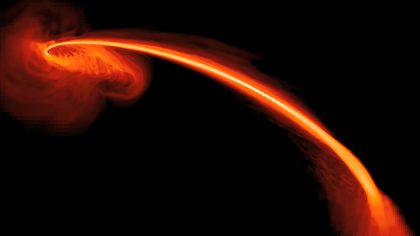SUMMARY
This is AI generated summarization, which may have errors. For context, always refer to the full article.

MANILA, Philippines – For the first time, astronomers have seen a “supermassive” black hole in the process of devouring a star.
With the aid of the Galaxy Evolution Explorer in space, and the Pan-STARRS1 telescope in Hawaii, a team of astronomers was able to observe a star 2.7 billion light-years away from Earth being swallowed by a black hole.
It is the first time scientists were able to observe such phenomenon from start to finish, the US space agency NASA said Wednesday, May 2.
The team’s findings were published on the online edition of the journal Nature on Wednesday.
A black hole is a region in space with a very strong gravitational field from which nothing can escape – even light. Scientists say there could be millions of black holes in the universe, formed due to stars dying out.
The astronomers, led by Suvi Gezari of the Johns Hopkins University in Baltimore, monitored hundreds of thousands of stars using the 2 telescopes.
In June 2012, the team was able to monitor a bright flare of ultraviolet light from a galaxy with a previously dormant black hole, which rang alarm bells – the phenomenon appeared to be a supernova, but the event lasted too long, according to the researchers.
“The longer the event lasted, the more excited we got, because we realized this is either a very unusual supernova or an entirely different type of event, such as a star being ripped apart by a black hole,” Armin Rest of the Space Telescope Science Institute, part of the team, said in a press release by NASA.
They subsequently observed the phenomenon for the next 12 months, and upon analysis, the team found out they were looking at a black hole literally in the process of killing a star.
“When the star is ripped apart by the gravitational forces of the black hole, some part of the star’s remains falls into the black hole while the rest is ejected at high speeds… We are seeing the glow from the stellar gas falling into the black hole over time,” Gezari was quoted by in a NASA release.
“We’re also witnessing the spectral signature of the ejected gas, which we find to be mostly helium. It is like we are gathering evidence from a crime scene. Because there is very little hydrogen and mostly helium in the gas, we detect from the carnage that the slaughtered star had to have been the helium-rich core of a stripped star,” Gezari added.
In the past, scientists were only able to observe the remnants of such phenomenon. – Rappler.com
Add a comment
How does this make you feel?
There are no comments yet. Add your comment to start the conversation.